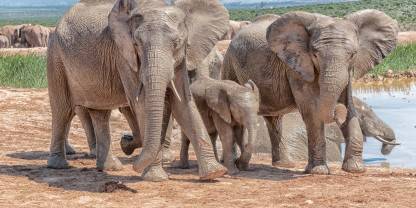Average Expert Rating
Rating Breakdown
Write a User ReviewSo much more than a bunch of happy elephants
Currently, the greater Addo National Park is around 3,000km2 in size and includes six distinct eco-types within its boundaries: the Cape Floral fynbos habitat, the arid and rocky Nama Karoo, Afromontane evergreen forests, subtropical thickets, a coastal belt, and a huge 1,200km2 marine reserve where penguins, fur seals, whales, and great white sharks abound.
I love the self-drive safari options in the popular ‘Main Camp’ and ‘Colchester’ sections, but more than that, I enjoy exploring the many little-known gems in this park. I have stayed up in the mountains in the charming Narina tented camp, and I have explored Addo’s misty forests on my quest to find rare and colorful birds.
I have ventured in my 4x4 over the Zuurberg mountains and seen black rhinos, and I have trekked the 2-day Alexandria hiking trail through desert-like dunes along Addo’s Woody Cape coastal section. In fact, there are numerous places to hike in Addo. Not a lot of people know that.
You can also ride horses among wildlife, stay in a five-star concession, hang out with habituated meerkats, and even go shark cage diving from the nearby town of Gqeberha.
All in all, Addo is bigger, better, and far more diverse than most people realize.
Elephants Galore
Addo is South Africa's third-largest national park, covering 1800 sq km, and a popular stop for both self-drive and guided safaris, situated near Port Elizabeth and the Garden Route. While it can get busy (book well ahead to stay here over Christmas), the park certainly lives up to its name, with over 600 elephants comprising Africa's most concentrated pachyderm population. I experienced my most memorable elephant sightings here: thirsty herds hurrying to waterholes, trunks swinging and cute calves scurrying; and the surly adolescent male who passed our vehicle, his glaring eye sizing up our camera lenses. The sprawling park covers numerous environments, from the Zuurberg Mountains to the coastline; the main section is pleasingly hilly, with viewpoints and ridges to drive along. My hottest tip, for small groups, is the Narina Bush Camp. It's a blissful, electricity-free getaway with a gas-powered fridge, donkey-boiler shower, and an inviting waterhole and terrace.
Elephants, elephants & more elephants
Read more
the Spekboom Trail is well-recommended. The trail is set within a fenced-off botanical reserve, meaning you can roam through it freely without fear of being charged by an elephant or rhino or ending up the main meal of a hungry lion.Breathtakingly Close Encounters with Elephants
It was grey and drizzling on my most recent visit to Addo, and hopes were not high at spotting much. What followed were the three most exhilarating elephant sightings I’ve ever had. It’s pretty much impossible not to see elephants at Addo. They amble down the dirt roads in herds. They congregate at water holes to frolic and sip. They stop in the middle of the road, halting traffic for a while until drivers pluck up the courage to inch by, passing so close a passenger could easily reach out to touch a wrinkly knee. On paper, the park is home to the Big Five, but realistically you’re very unlikely to see them all. Don’t come here with the goal of checking a dozen species off your list. Instead, come to get the kind of in-depth elephant encounters that you’ve always dreamed of when watching a David Attenborough documentary.
Huge herds of elephants and much, much more
It’s about time that Addo changed its name, not for any lack of elephants (the park started out as an elephant sanctuary, their numbers now exceed 550, and I’d be amazed if you didn’t see several herds during your visit), but because there are so many other species here, too, from endemic flightless beetles to hyenas, black rhinos and leopards.
I love the great variety of habitats and activities on offer here, including wildlife-watching on horseback, and there’s even more more in the pipeline. Already a Big Five park and the third largest protected area in South Africa, Addo is growing – there are plans to expand its coastal section into a marine reserve. That will, of course, make it a Big Seven park, six and seven in this instance being great white sharks and whales.
The fact that Addo lies within a malaria-fee region is a tremendous bonus. If your stay in South Africa includes the Garden Route or Port Elizabeth, you’d be crazy to miss out on Addo, even if you only have time for a quick day-trip.
South Africa’s premier park for elephant-watching
Thanks to rapid expansion in recent years, Addo is South Africa’s third largest park after Kruger and the Kgalagadi. The total 1640-sq-kms encompass large bush areas as well as fragmented pockets of varied habitats, from woodlands in the Little Karoo to sand dunes along the Indian Ocean. Like most visitors to Addo, I’ve always seen elephants in the principle game-viewing area around Main Camp thanks to flat bush, waterholes and pans—one time a magnificent herd of more than 100-strong splashing around in their morning bath. Main Camp’s underground hide overlooking a waterhole is another great vantage-point too. Cape buffalo, zebra, and antelope are common, lion and spotted hyenas are occasionally seen, and look out for the curious flightless dung beetle. Also explore the other distinct regions for their different habitats and animals – for example black rhino are present in the Darlington area, while the Sundays River in the Zuurberg section is home to hippo. An all-year-round park, Addo is ideal for novice game-watchers and children, and of course all elephant-lovers.

